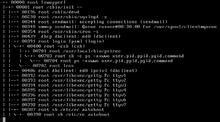pstree
pstree is a Linux command that shows the running processes as a tree. It is used as a more visual alternative to the ps command. The root of the tree is either init or the process with the given pid. It can also be installed in other Unix systems.

pstree output in FreeBSD
In BSD systems, a similar output is created using ps -d, in Linux ps axjf[1] produces similar output.
Examples
pstree pid
user@host ~$ pstree 1066
rsyslogd─┬─{in:imjournal}
└─{rs:main Q:Reg}
pstree username
user@host ~# pstree username
dbus-daemon───{dbus-daemon}
dbus-launch
bash───firefox─┬─6*[{Analysis Helper}]
├─{BgHangManager}
├─{Cache2 I/O}
├─{Compositor}
├─{GMPThread}
├─{Gecko_IOThread}
├─{Hang Monitor}
├─{ImageBridgeChil}
├─{ImageIO}
├─{JS Watchdog}
├─{Link Monitor}
├─{Socket Thread}
├─{SoftwareVsyncTh}
├─{StreamTrans #1}
├─{Timer}
└─{gmain}
gollark: We've been through this. Maybe. Possibly.
gollark: This is 47 minutes. I am willing to watch up to exactly 76 seconds.
gollark: No you don't.
gollark: Because that is, broadly speaking, the point of autofill?
gollark: I only need the 2FA code.
References
External links
- The psmisc package
- The pstree Command by The Linux Information Project (LINFO)
- Gnome Process Tree
- – Linux User Commands Manual
- – Solaris 10 User Commands Reference Manual
This article is issued from Wikipedia. The text is licensed under Creative Commons - Attribution - Sharealike. Additional terms may apply for the media files.